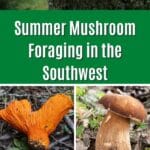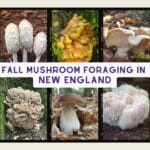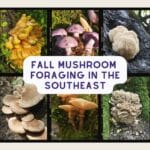Summer in the Southwest is an interesting time for mushroom foraging. There is extreme heat, then crazy monsoon rains, and you really have to just go with the weather. On top of this, the elevations and forest vs. desert areas make each section of the Southwest its own mini ecosystem. This can make mushroom foraging challenging but certainly not impossible. Summer mushroom foraging in the Southwest is excellent after the monsoons hit.
Foraging mushrooms in the Southwest means adapting to the seasons and weather and taking advantage of the rains when they occur. The monsoons start at different times in different areas but expect the best mushroom foraging to be from July to September after consistent rain. And, if you live in the low desert, plan some trips out to the mountains. In some areas, the mountain snows will still be melting into the early summer, providing good moisture that fungi need to fruit.
Other good areas to search for fungi are around cottonwood washes, riverbeds, and landscaped areas that receive regular watering (as long as you trust that no problematic chemicals are also used to maintain them).
An unfortunate side effect of all the rains that bring mushrooms is that they also bring bugs! You’ll be competing with gnats, slugs, and other insects that are just as thrilled to find the mushrooms.

Speaking of bugs, remember to apply some good bug and tick spray when you’re out foraging. We love these permethrin-treated socks (and other clothing)—they really work to keep the ticks away. Also, we don’t go in the woods without these mosquito head nets to protect our faces from the relentless mosquitos and black flies. They may look a little funny, but they’re totally worth it!
If I’m missing any Southwest summer mushrooms, please let me know in the comments! And check out the other seasonal guides: Winter Mushroom Foraging in the Southwest, Spring Mushroom Foraging in the Southwest, and Fall Mushroom Foraging in the Southwest.
Summer Mushroom Foraging In The Southwest
Chanterelles
These brilliantly colored mushrooms are a jewel of the forest. Chanterelles are among the best edible mushroom species with a soft, fruity scent and meaty texture. They taste a little fruity and slightly sweet and are excellent stir-fried, in soups and on pizza.
Finding chanterelles takes a little searching, but luckily, once you find them, they’re usually in large, scattered, prolific patches. It’s easy to walk away with a good haul. These won’t show up until there are significant rains and humidity, but once they do, they’ll be abundant.
There are many chanterelle species in North America, and one primary species shows up in the Southwest. The southwestern chanterelle doesn’t look quite like the type species, which is stunningly golden yellow. This is a different species with slightly different coloring, but it is still distinguishable as a chanterelle and absolutely delicious.
Cantharellus roseocanus – This is the primary southwestern chanterelle species. Its cap is pale orange or yellow and fades in the sun, so it often looks tannish-white or muted. The gills underneath, though, are a brilliant orange, which really stands out compared to the cap. This species fruits around pine and spruce trees, especially Bishop pine, lodgepole pine, jack pine, and Sitka spruce. Learn more about all the different chanterelle species here.

Chicken of the Woods
The delicious chicken of the woods mushroom starts showing up in mid-summer and continues fruiting through fall. This thick, meaty mushroom is excellent fried, grilled, barbequed, and baked. It is also one of the easiest to identify. Unfortunately, chicken of the woods doesn’t follow a set fruiting schedule. Each specimen seems to be on its own timeline, making it challenging to predict when to look. But, if you do find one, make sure to mark the spot because it will return the following year.
There are some ways to improve your chances of finding this top edible mushroom, though. The chicken of the woods in the Southwest is Laetiporus gilbersonii, which looks just like the type species L. sulphureus. It is bright orange to yellow with bright yellow pores and is very hard to miss. It grows on dead or dying oak and eucalyptus trees. If you want to find this species, find some good oak or eucalyptus groves and check regularly.
If the mushroom gods are feeling generous, you’ll find a massive fruiting of this mushroom. Chicken of the woods often grows in tall stacks up a tree or across a log. It grows fast, so if you see a baby one starting, make sure not to leave it too long – 2-4 days, and it’ll be at least double the size.

Puffballs
The giant puffball is a thrill to find – this mushroom gets as large as a volleyball and looks a lot like one, too. It is all white, rounded, and grows in grassy areas like meadows and fields. A mushroom find like this is enough for quite a few puffball meals! Remember to always make sure the interior is completely white before cooking it up.
While the quintessential giant puffball (Calvatia gigantea) doesn’t occur in the southwest (it only fruits east of the Rocky Mtns), there are other massive puffball species around.
- Calvatia boonia (Western Giant Puffball) — This is a big-un! It can reach up to 24 inches wide, but more often is 6-12 inches wide and 10-12 inches tall. It is all white and round and fruits in meadows and fields. The outer flesh breaks into polygonal sections as it grows that make it look sculpted. They may look like upraised pointed warts.
- Calvatia cyathiformis (Purple-spored Puffball) — This species is softball to soccer ball sized and tan or light brown with a scaly outer skin. It starts off rounded, then forms a lower section that makes it look like a loaf of bread or wide lightbulb.
In addition to this massive puffball species, there are also a lot of much smaller puffballs that are also good to eat. You have to collect a lot more to make a meal, but they’re a nice edible mushroom.
Puffballs are rather bland tasting and are often compared to tofu. Their interior is thick yet pillowy, a lot like a marshmallow. They take on the flavor of whatever they are cooked with and are great fried, used in place of pizza crust, and added to stir-fries.

Lobster Mushrooms
The lobster mushroom is a top edible species with a weird growth habit. It is actually the result of another fungi species being parasitized by this one. It’s an incredible (almost unbelievable) transformation that turns a somewhat decent edible mushroom into a prized wild edible mushroom. Lobster mushrooms are thick, dense, and have a slightly sweet flavor.
Some people say lobster mushrooms taste somewhat like ocean lobsters, but that is inaccurate. It is likely a trick of the mind based on visual similarity. Lobster fungi are delicious, but they don’t taste like seafood. That distinctive reddish coloring sure is spot on, though, with the ocean lobster.
Lobster mushrooms fruit throughout the summer after good rains. They are usually pretty easy to spot due to their brilliant red or orange coloring, but they are also excellent at tucking themselves under needle debris. Keep an eye out for mushroom “shrumps” along pathways and trails. They parasitize Russula species, which tend to grow in disturbed areas. The best place to look is around Ponderosa Pines. A great thing about this species is that it usually reoccurs in the same place every year. So, if you find them, be sure to mark the spot.

King Bolete (aka Porcini, Cep, and Piggies)
From late August through the fall, boletes start to show up as long as there has been good rain throughout the previous months. The king bolete is the most prized of this family, and for good reason. It is a top edible species with a dense, meaty flesh and nutty mushroomy taste. King boletes are one of the most sought-after species in the world.
In the Southwest, king boletes fruit in association with conifers, specifically pines, hemlocks, and firs. They may also fruit with beech, chestnut, and chinquapin trees. As you can see, this is a hardy, adapting species.
King boletes fruit after plentiful rains and warm, humid weather that is combined with a drop in soil temperatures. A strong monsoon season will bring out lots of boletes, including the king. If there’s a drought or lack of humidity, they might not show up at all.

White King Bolete/Barrow’s Bolete (Boletus barrowsii)
Another robust bolete species that is prime in the kitchen is the white king bolete. They get huge and have stout stems and thick, dense caps. White king boletes have irregularly rounded or lumpy white caps and grow in association with Ponderosa pines.
This delicious bolete may grow alone but also in wide, scattered groupings. It appears in the middle of or towards the end of monsoon season, usually in mid-August into fall.
For a long time, this species was considered a white version of Boletus edulis (described above), but recent DNA analysis determined it was closely related but not the same. Many say the white king bolete tastes better than the original king bolete!

Other Summer Mushrooms In The Southwest
You’ll probably stumble across lots of Russula and milky cap mushrooms. These two types look pretty similar, and some are edible, but not all of them. These mushrooms, even though they are edible, are not included in this list because most of them aren’t that fantastic. Some are decent, but not compared to the prime edible species listed above.
Many boletes are also starting to show up in the forest, in addition to the King Bolete and Barrow’s Bolete, which are already listed. Make sure you read up on the boletes before foraging them. They can be tricky, though thankfully, not super dangerous; they just taste really bad if you get the wrong ones.










Leave a Reply